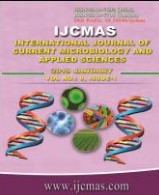


 National Academy of Agricultural Sciences (NAAS)
National Academy of Agricultural Sciences (NAAS)

|
PRINT ISSN : 2319-7692
Online ISSN : 2319-7706 Issues : 12 per year Publisher : Excellent Publishers Email : editorijcmas@gmail.com / submit@ijcmas.com Editor-in-chief: Dr.M.Prakash Index Copernicus ICV 2018: 95.39 NAAS RATING 2020: 5.38 |
Honey and lemon juice are ingredients used indigenously to treat a number of microbial infections. Our aim was to study the in vitro antimicrobial activity of honey and lemon fruit juice mixtures against clinical isolates from patients with respiratory tract infections. Mixtures of honey and lemon juice were prepared at various proportions (90:10, 75:25, 50:50, 25:75 and 10:90% v/v respectively) and tested for antimicrobial activity against clinical isolates using agar well diffusion method. MICs and MBCs of the most active test mixture proportion were determined using broth and agar media respectively. Cirprofloxacin (for bacteria) and ketoconazole (for yeast) were used as reference substances. Data were analysed with the help of statistical package for social sciences (SPSS), version 20. Student Newman-Keuls test was used to compare inhibition diameters. Generally, the diameter of microbial growth inhibition zones increased with decreasing proportion of honey in the mixtures. Staphylococcus aureus was most sensitive to the honey/lemon mixture of 25/75% (v/v) producing a growth inhibitory diameter of 14 mm. Two test mixture proportions (75/25 and 90/10% v/v) were not able to inhibit the growth of S. aureus and Streptococcus pyogenes. Candida albicans was susceptible at 25/75% (8.66 mm) and 10/90% (11.33) test concentrations. The MIC values for S. aureus and S. pyogene were recorded as 60% concentration of test mixture. C. albicans had a higher MIC value (80%). All the MBC values for the test microorganisms were considered greater than 80% of test mixtures. Appropriate mixtures of honey and lemon juice (lemon 50-75% for bacteria and 75-90% for yeast) could be a better alternative treatment against some infectious diseases.
 |
 |
 |
 |
 |